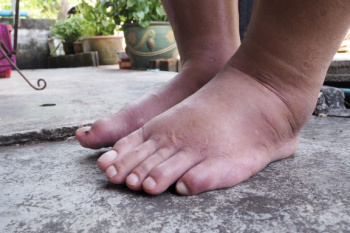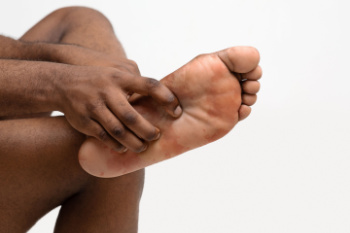Items filtered by date: October 2024
Reminder: When Was the Last Time...?
Risk Factors for Stress Fractures

Foot stress fractures are hairline cracks in the bones often caused by repetitive strain. Several risk factors can increase the likelihood of developing stress fractures, especially in the feet. People who participate in high-impact activities, such as running, dancing, or gymnastics, face a higher risk of stress fractures from the repeated pressure and pounding on their feet. Women, particularly those experiencing menstrual irregularities, may be more prone to fractures due to lower bone density. Conditions like osteoporosis or insufficient intake of vitamin D and calcium can further weaken bones and increase the risk. Foot structure issues, such as high arches or flat feet, can also lead to stress fractures, as well as wearing poor footwear or sudden changes in activity surfaces. Podiatrists play a key role in diagnosing and managing foot stress fractures. This foot doctor may use imaging techniques such as MRI scans to confirm the injury. If you have foot pain that may indicate a stress fracture, it is suggested that you schedule an appointment with a podiatrist for an exam and treatment.
Stress fractures occur when there is a tiny crack within a bone. To learn more, contact Dr. John P. Beaupied from Palos Podiatry. Our doctor can provide the care you need to keep you pain free and on your feet.
How Are They Caused?
Stress fractures are the result of repetitive force being placed on the bone. Since the lower leg and feet often carry most of the body’s weight, stress fractures are likely to occur in these areas. If you rush into a new exercise, you are more likely to develop a stress fracture since you are starting too much, too soon. Pain resulting from stress fractures may go unnoticed at first, however it may start to worsen over time.
Risk Factors
- Gender – They are more commonly found in women compared to men.
- Foot Problems – People with unusual arches in their feet are more likely to develop stress fractures.
- Certain Sports – Dancers, gymnasts, tennis players, runners, and basketball players are more likely to develop stress fractures.
- Lack of Nutrients – A lack of vitamin D and calcium may weaken the bones and make you more prone to stress fractures
- Weak Bones – Osteoporosis can weaken the bones therefore resulting in stress fractures
Stress fractures do not always heal properly, so it is important that you seek help from a podiatrist if you suspect you may have one. Ignoring your stress fracture may cause it to worsen, and you may develop chronic pain as well as additional fractures.
If you have any questions, please feel free to contact our office located in Palos Heights, IL . We offer the newest diagnostic and treatment technologies for all your foot care needs.
Key Reasons for Foot and Ankle Swelling

Foot and ankle swelling is a common issue that can result from various factors, often indicating underlying health concerns. One significant reason for is being overweight, as excess body weight places additional pressure on the feet and ankles, leading to fluid retention. Older adults are also more susceptible to swelling due to natural aging processes that affect circulation and fluid balance. Blood clots can pose serious risks, causing localized swelling and requiring immediate medical attention. Additionally, chronic vein conditions, such as venous insufficiency, prevent blood from flowing properly back to the heart, resulting in swelling and discomfort. If you are suffering from swollen feet and ankles, it is suggested that you contact a podiatrist who can determine the cause and offer appropriate relief and treatment solutions.
Swollen feet can be a sign of an underlying condition. If you have any concerns, contact Dr. John P. Beaupied of Palos Podiatry. Our doctor can provide the care you need to keep you pain-free and on your feet.
Swollen feet are a common ailment among pregnant women and people who stand or sit for extended periods. Aging may increase the possibility of swollen feet and patients who are obese often notice when their feet are swelling too. There may be medical reasons why swollen feet occur:
- Phlebitis - A condition that causes the veins to become inflamed and can also cause leg pain.
- Liver disease - This may lead to low blood levels of albumin which is a protein. This can cause fluid in the blood to pass into the tissues and several areas of the body can become swollen.
- Heart failure - When the heart doesn’t pump properly the blood that is normally pumped back to the heart can pool in the veins of the legs causing swollen feet.
- Kidney disease - One of the main functions of the kidneys is releasing excess fluid in the body. This type of condition can make it difficult for the kidneys to function properly, and as a result the feet may become swollen.
- Deep-vein thrombosis (DVT)- This is a serious condition where blood clots form in the veins of the legs. They can block the return of blood from the legs to the heart which may cause the feet to swell. It is important to be treated by a podiatrist if this condition is present.
Swollen feet can also be caused by bone and tendon conditions, including fractures, arthritis, and tendinitis. Additionally, there may be skin and toenail conditions and an infection may cause the feet to swell. Patients who take medicine to treat high blood pressure may be prone to getting swollen feet.
Many patients elevate their feet to help relieve the swelling and this is generally a temporary remedy. When a podiatrist is consulted the reason behind the swelling can be uncovered and subsequently treated.
If you have any questions please feel free to contact our office located in Palos Heights, IL . We offer the newest diagnostic tools and technology to treat your foot and ankle needs.
Structure and Function of the Human Foot

Foot bone anatomy is essential for understanding how the foot supports movement and balance. The foot is divided into three main sections, which are the hindfoot, midfoot, and forefoot. The hindfoot consists of the talus and calcaneus, or heel bone, which play a critical role in weight bearing and shock absorption during walking and running. The midfoot comprises five tarsal bones that provide flexibility and stability, allowing for efficient movement. The forefoot includes the metatarsals and phalanges, which are vital for balance and propulsion. Together, these sections work in harmony to absorb impact, support the body, and facilitate walking, running, and jumping. A strong understanding of foot bone anatomy helps in identifying potential issues and developing effective treatment strategies for foot-related problems. If you have developed a foot condition, it is suggested that you consult a podiatrist who can treat various foot problems.
If you have any concerns about your feet, contact Dr. John P. Beaupied from Palos Podiatry. Our doctor can provide the care you need to keep you pain-free and on your feet.
Biomechanics in Podiatry
Podiatric biomechanics is a particular sector of specialty podiatry with licensed practitioners who are trained to diagnose and treat conditions affecting the foot, ankle and lower leg. Biomechanics deals with the forces that act against the body, causing an interference with the biological structures. It focuses on the movement of the ankle, the foot and the forces that interact with them.
A History of Biomechanics
- Biomechanics dates back to the BC era in Egypt where evidence of professional foot care has been recorded.
- In 1974, biomechanics gained a higher profile from the studies of Merton Root, who claimed that by changing or controlling the forces between the ankle and the foot, corrections or conditions could be implemented to gain strength and coordination in the area.
Modern technological improvements are based on past theories and therapeutic processes that provide a better understanding of podiatric concepts for biomechanics. Computers can provide accurate information about the forces and patterns of the feet and lower legs.
Understanding biomechanics of the feet can help improve and eliminate pain, stopping further stress to the foot.
If you have any questions please feel free to contact our office located in Palos Heights, IL . We offer the newest diagnostic and treatment technologies for all your foot and ankle needs.
Types of Ankle Braces After a Sprain

Selecting the right brace for an ankle sprain is important to ensure proper healing and support during recovery. Several types of ankle braces are available depending on the severity of your injury and activity level. Lace-up braces provide a snug, customizable fit with laces and straps. These are ideal for athletes needing extra support or recovering from strains. For mild sprains or chronic instability, compression sleeves offer both light support and stability for daily activities. If your injury is more severe, moderate to maximum support braces, featuring adjustable straps or side stays, can help prevent further injury while maintaining mobility. Full-shell protection, like a boot brace, is recommended for serious sprains or fractures, providing maximum stability. Features include a rocker sole to reduce pressure on the foot during walking. A podiatrist can offer advice on the appropriate ankle brace needed for your specific injury. If you have endured a sprained ankle, it is suggested that you schedule an appointment with a podiatrist for treatment.
Ankle sprains are common but need immediate attention. If you need your feet checked, contact Dr. John P. Beaupied from Palos Podiatry. Our doctor can provide the care you need to keep you pain-free and on your feet.
How Does an Ankle Sprain Occur?
Ankle sprains take place when the ligaments in your ankle are torn or stretched beyond their limits. There are multiple ways that the ankle can become injured, including twisting or rolling over onto your ankle, putting undue stress on it, or causing trauma to the ankle itself.
What Are the Symptoms?
- Mild to moderate bruising
- Limited mobility
- Swelling
- Discoloration of the skin (depending on severity)
Preventing a Sprain
- Wearing appropriate shoes for the occasion
- Stretching before exercises and sports
- Knowing your limits
Treatment of a Sprain
Treatment of a sprain depends on the severity. Many times, people are told to rest and remain off their feet completely, while others are given an air cast. If the sprain is very severe, surgery may be required.
If you have suffered an ankle sprain previously, you may want to consider additional support such as a brace and regular exercises to strengthen the ankle.
If you have any questions please feel free to contact our office located in Palos Heights, IL . We offer the newest diagnostic and treatment technologies for all your foot and ankle needs.
Symptoms and Risk Factors for Plantar Fasciitis

Plantar fasciitis affects millions of people every year. This condition occurs when the plantar fascia, a thick band of tissue that supports the arch of the foot, becomes inflamed due to repeated stress. Symptoms of plantar fasciitis typically include sharp pain in the heel or arch, particularly after periods of rest or first thing in the morning. Swelling and tightness in the Achilles tendon may also accompany this pain, which often worsens after prolonged activity or standing in shoes that lack proper support. Risk factors for developing plantar fasciitis include spending long hours on your feet, engaging in high-impact activities, wearing poorly supportive footwear, and having flat feet or high arches. A podiatrist can recommend correct footwear, exercises, and custom orthotics to alleviate pain. If you are experiencing heel pain from plantar fasciitis, it is suggested that you schedule an appointment with a podiatrist for a diagnosis and treatment.
Plantar fasciitis is a common foot condition that is often caused by a strain injury. If you are experiencing heel pain or symptoms of plantar fasciitis, contact Dr. John P. Beaupied from Palos Podiatry. Our doctor can provide the care you need to keep you pain-free and on your feet.
What Is Plantar Fasciitis?
Plantar fasciitis is one of the most common causes of heel pain. The plantar fascia is a ligament that connects your heel to the front of your foot. When this ligament becomes inflamed, plantar fasciitis is the result. If you have plantar fasciitis you will have a stabbing pain that usually occurs with your first steps in the morning. As the day progresses and you walk around more, this pain will start to disappear, but it will return after long periods of standing or sitting.
What Causes Plantar Fasciitis?
- Excessive running
- Having high arches in your feet
- Other foot issues such as flat feet
- Pregnancy (due to the sudden weight gain)
- Being on your feet very often
There are some risk factors that may make you more likely to develop plantar fasciitis compared to others. The condition most commonly affects adults between the ages of 40 and 60. It also tends to affect people who are obese because the extra pounds result in extra stress being placed on the plantar fascia.
Prevention
- Take good care of your feet – Wear shoes that have good arch support and heel cushioning.
- Maintain a healthy weight
- If you are a runner, alternate running with other sports that won’t cause heel pain
There are a variety of treatment options available for plantar fasciitis along with the pain that accompanies it. Additionally, physical therapy is a very important component in the treatment process. It is important that you meet with your podiatrist to determine which treatment option is best for you.
If you have any questions, please feel free to contact our office located in Palos Heights, IL . We offer the newest diagnostic and treatment technologies for all your foot care needs.




